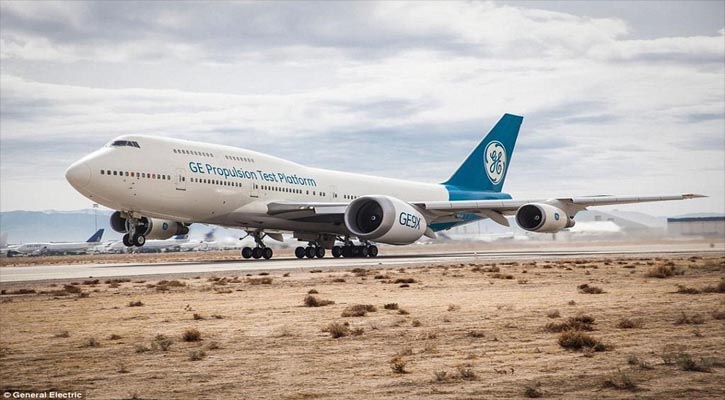World's biggest jet engine takes to the skies
4 || risingbd.com

Risingbd Desk: Incredible footage has revealed the moment that the world's biggest jet engine took to the skies for the first time, ahead of its planned maiden commercial flight in 2020.
The huge GE9X powerplant, which is as wide and tall as the fuselage of a Boeing 737, is being built for the latest version of the firm's long-haul 777, the 777X 'megaplane'.
General Electric has now begun flight trials of the prototype, after delays caused by technical problems stopped tests originally planned for late last year.
The GE9X was attached to the plane alongside smaller engines to allow engineers to put it through the motions of flight without risking the safety of passengers onboard.
It features a massive fan stretching 134 inches in diameter, more than 11 feet, and fits into a 14-and-a-half-foot nacelle.
A special Boeing 747 test aircraft flew from Victorville, California, for four hours with the new GE9X engine mounted under its left wing, dwarfing the plane's three other engines.
The flight marks the beginning of a test campaign scheduled to last several months, before the aircraft itself takes to the skies under its own power in the first quarter of next year.
The engine will eventually power the 777X, a plane that will have the widest wingspan of any aircraft: 235 feet, five inches (71.8 metres), making it wider than four 53-foot (16-metre) semi-truck trailers parked end to end.
It is so big, Boeing has developed hinges on its wingtips. The hinges will fold up, allowing the plane to shorten its wingspan when it's rolling across airport taxiways, the first design of its kind on any commercial airliner.
The hinged wingtips will measure 12 feet, and locking pins will prevent them from folding during flight, Boeing told CNN.
Inside, the 777-9X will seat at least 400 passengers, 34 more than the 777-9X's competitor - the Airbus A350-1000.
The 777-9X cabin will be 16 inches (40 centimeters) wider than the A350-1000, Boeing says, allowing economy-class seat widths up to 18 inches (46 centimeters).
'The GE9X and Victorville teams have spent months preparing for flight testing of the engine, and their efforts paid off today with a picture-perfect first flight,' added Ted Ingling, general manager of the GE9X program at GE Aviation.
'Today's flight starts the beginning of the GE9X flight test campaign that will last for several months, allowing us to accumulate data on how the engine performs at altitude and during various phases of flight.'
Testing of the engine was seen as a critical step towards development of the 777X aircraft family, a new version of the 777 'mini-jumbo'.
Boeing asked GE to develop an engine strong enough to power its 777X jet, which then prompted other airlines, including Emirates, Lufthansa and Qatar Airways, to place an order.
It will have the largest front fan in the world, GE says, at 134 inches (11 feet) in diameter, while its inlet duct measures 18 feet (215 inches) by 12 feet (145 inches).
Not only has GE built the world's largest jet engine, it built the world's first American Jet engine in 1942.
The J31 was the first jet engine to be mass-produced in the United States.
It had a maximum thrust of 1,650 pounds and weighed 850 lbs (385 kg) with an rpm of 16,500.
The J31 was developed from the original American-built jet engine, the General Electric I-A (which was a copy of the highly-secret British 'Whittle' engine).
The I-A powered the early test flights of the U.S.'s first jet aircraft, the Bell XP-59A Airacomet, and the more powerful J31 was used in production P-59As and P-59Bs.
Source: The Mail
risingbd/March 17, 2018/Mukul
risingbd.com


































